RFID Tags: Encode Versus Associate
Posted by Suzanne Smiley on Nov 26, 2019
Introduction
Encoding information directly onto a tag’s memory bank is not the only way to read information about a tagged asset, this can also be done with an associated database. In fact, using a database and linking a tag’s EPC number with a specific file or line of information is more common than encoding specific information onto a tag.
Association is defined as the act of connecting or linking two pieces of data together, in this case, the direct connection of an RFID tag’s unique EPC number with data on a database or spreadsheet. Software or middleware enables this seamless connection and allows for a unified means of data exchange. When a reader reads the EPC number, the screen or connected computer/tablet displays the tagged asset’s linked information.

Let’s take a look at the three most common situations where it is better to associate versus encode data.
Situation #1 – Less Information on a Tag

RFID tags generally have smaller memory banks for a reason – tags are not intended to hold a large amount of information. Because memory banks typically only hold small amounts of information, they can be read in milliseconds, allowing users to inventory large quantities of assets in minutes. Usually RFID readers simply read the EPC memory bank when reading, or the TID memory bank, if selected.
If the application requires the reader to read more than one memory bank, for instance if there is also pertinent information in the User Memory Bank, reading each tag’s data will take longer. Each memory bank will likely have to be read individually and in succession, adding additional time to each read. The extra time per tag read will result in longer inventory time, and possibly even incomplete data being returned.
So how much information is too much? It is recommended to stick to reading only one memory bank, the EPC or TID bank, and writing the maximum amount of characters allowed by the tag's memory. While encoding space is limited, a database can help you associate a theoretically endless amount of information to one tagged asset that populates upon reading.
Summary:
• Associate if a high amount of data is needed
• Reading more than one memory bank is not typically recommended for quick-inventory applications
• Associating via a database theoretically allows for an endless amount of information
Situation #2 – Fewer Rewrites

If an application needs to continually update or rewrite data to be successful, the application should probably associate via a database instead of writing and rewriting on the tag. As previously stated, RFID tags are typically meant to hold a limited, unique amount of information, and writing is typically a non-repeated process.
Rewriting information or writing additional information also leaves room for human error. If the tag needs to be continually updated, especially by different users, there is a higher probability that incorrect information will eventually be encoded on the tag.
Rewriting the tag via an automatic process, in place of a manual process, eliminates the chance of human error. However, this approach introduces the possibility and increases the chance of write failure. Encoding an RFID tag takes more power and requires more time than reading a tag. So, for instance, if a tag is consistently rewritten on an automatic assembly line and is not in the reader’s read zone for long enough, the tag will have a write failure because the tag did not receive enough power to encode completely.
What is the difference in rewriting or adding data to a tag and reusing an RFID tag? Rewriting or updating memory banks is different than reusing an RFID tag. Some tags, especially hard tags, are meant to be reused, which is why they are typically more expensive than disposable labels.
Reusing an RFID tag is common in asset tracking applications in instances where the asset is no longer tracked once it leaves the facility or completes a cycle. Because of this, it is easy to reassign the EPC number to a new item in a database. If the system is set up to keep historical data based on the unique item number or identification instead of the EPC number, no data will be overwritten once the EPC number is reassigned.
Summary:
• Tags are typically meant to have a small amount of unique information
• Rewriting opens the door for human errors and write failures
• Reusing tags is different from rewriting, and can be done by disassociating and re-associating or reassigning EPC numbers in a database
Situation #3 – Less Complexity

Writing information to an RFID tag can be as simple or complex as the user makes it and is usually determined by the type and format of information chosen to be encoded on a tag. Examples of a simple encoding process would be to use the unique EPC pre-encoded on each RFID tag, or re-encoding the EPC number to match a unique asset’s ID. The encoding process can become complex, especially when the need for human readable information is introduced.
In order to encode human readable information, the data must be converted from ASCII to Hex, encoded, and upon reading, converted back from Hex to ASCII. This process is more complex, typically takes additional software and/or algorithms, and is time-consuming. Additionally, users can struggle with the amount of information that can be added on the memory bank. A typical 96-bit memory bank holds 12 ASCII characters – which, for example, could be “CARPARTMOTOR”. If more than one car part motor is ever tagged, there will be no way to differentiate between the two.
Does that mean I shouldn’t use any ASCII to Hex Conversions? No, but using conversions will require a system to have more functionality than a basic read and display. The system still must convert bits to Hex, then Hex to ASCII in order to relay the information. A few applications that use ASCII typically do so in order to emulate an item identification number or barcode number that uses additional letters outside of the hexadecimal range, which is limited to letters A-F.
When, if at any time, should I use human readable information via ASCII characters? 95% of the time, human readable information is not needed or recommended; however, below are two instances of applications that commonly use human readable information.
1. If a system does not have network connectivity. If a system does not have any available network connectivity, including cellular connectivity, the only way to benefit from an RFID system is to select a tag with an extended memory bank and encode in ASCII, so that the data is human readable. Usually, this occurs in remote areas where a handheld reader is needed to locate and scan tags encoded with data like ‘Last Service Date’.
2. A smaller application with less need for data and functionality. In a very simple system that does not need to keep any historical data about the tagged item, all that is needed to facilitate the application is knowledge of an item’s location. These applications typically have a small pool of tags that are encoded uniquely and human readable for the basic function of identification or location.
Summary:
• Simple encoding and less conversions are recommended
• Human readable data makes reading and writing more complex
• Typically, when using human readable information, there is not enough space on the memory bank to make the information unique
• Use ASCII and/or human readable data sparingly and sensibly
Conclusion
Typically, association via a database is recommended because the process is simpler and more efficient. Association presents the possibility to link endless data that can be used to make informative decisions, now and in the future.
For more information about association versus encoding, comment below or contact us.
To read more about RFID tags, check out the links below!
